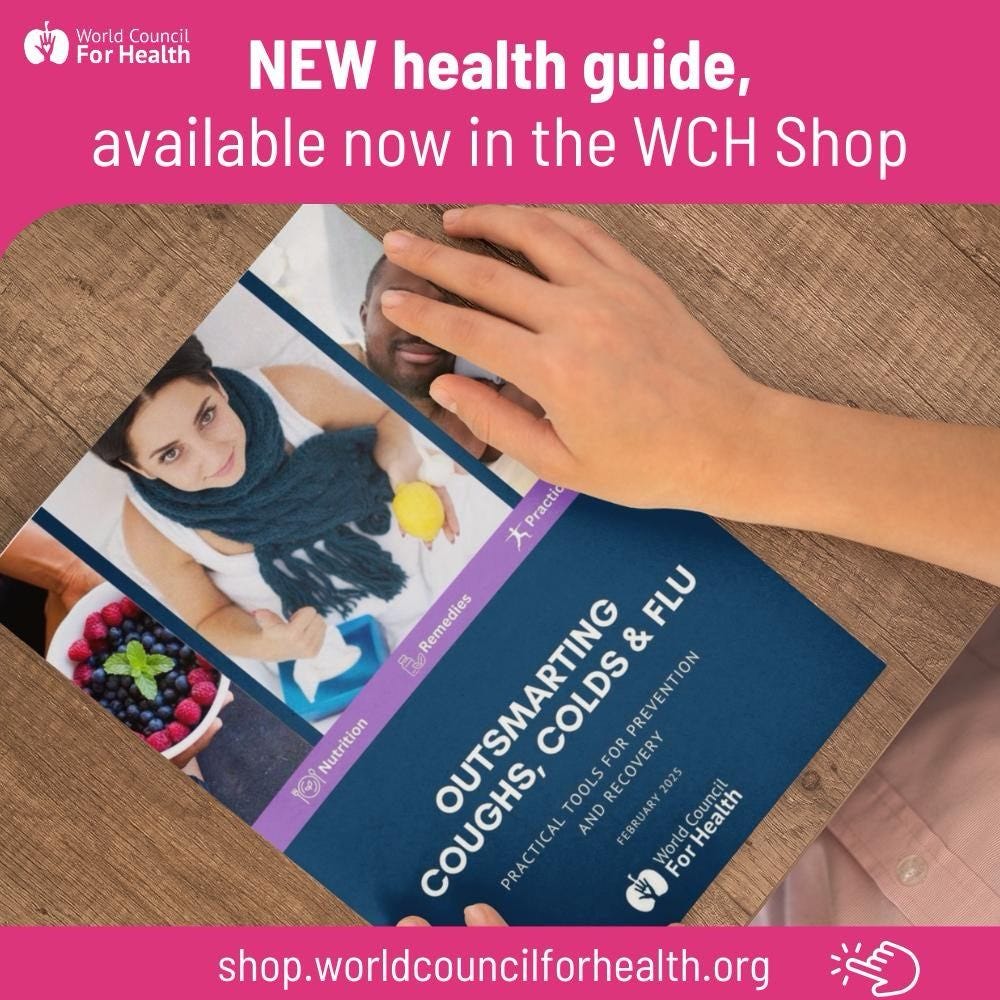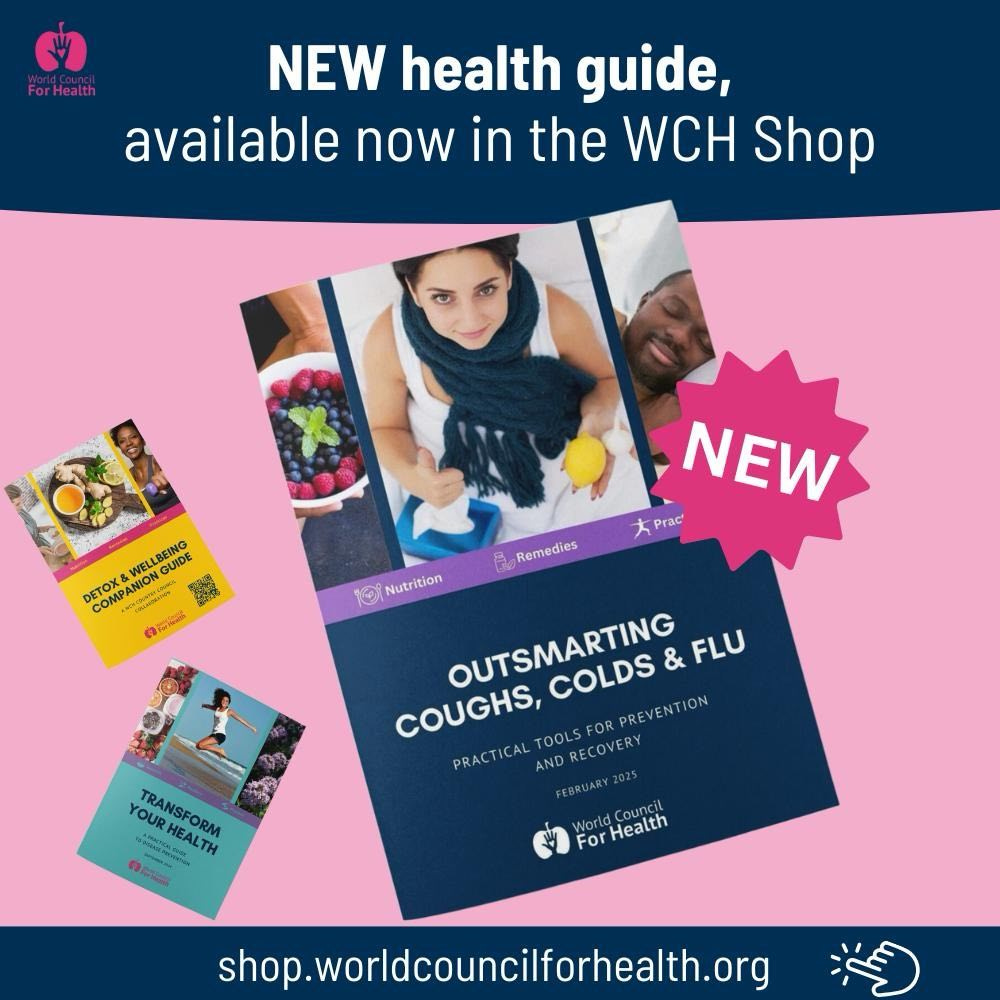UPDATED! A Common-Sense Approach to Respiratory Viruses: Part 3
Why every household should have nasal sprays and oral rinses in their medicine cabinet.
Life moves fast. Yesterday’s post was not quite the final version, but this one is. We’re also delighted to share our new guide on this topic, available in the WCH Shop as one of three here. Enjoy your weekend!
This is an additional, important and final part in our series on combating respiratory viruses. You can view Part 1 and Part 2 by clicking on the links.
The information in this post is is for general informational and educational purposes only. It does not constitute professional medical advice, diagnosis, or treatment. Always consult a qualified healthcare professional before making decisions about your health.
Part 3: The Power of Nasal Sprays and Oral Rinses (updated with Nitrous Oxide and VIRX)
Did you know the linings of your nose and mouth are your body’s first line of defence against respiratory viruses? These nasal and oral mucosa are where viruses like influenza, SARS-CoV-2 and others first land and attempt to gain entry into the body. When your mucosa are functioning optimally, they can vanquish pathogens before they gain any further traction.
So, it pays to give your mucosal immunity a boost. Here’s where nasal sprays and oral rinses come in. Simple, affordable and proven, they can help prevent infection, reduce viral load, and even attenuate disease progression. Let’s look at how this works and how to use them.
The nasal and oral mucosa are your body’s front line
These mucosa aren’t passive barriers, they’re active immune organs. The mucus they produce trap pathogens, and contain immune cells that neutralize invaders. However, when overwhelmed by a high viral load, this defense can falter. Nasal sprays and oral rinses bring welcome reinforcement. By directly targeting the site of viral entry, these interventions can help reduce viral replication and prevent systemic spread.
Three key principles for using nasal sprays and oral rinses
Comfort is key: Nasal solutions should be diluted sufficiently to avoid irritation or stinging. You want to support mucosal immunity, not damage it.
Proper technique: For nasal sprays, sniff the solution far back into the sinuses and then spit it out through the mouth. This may cause mild coughing or choking but ensures thorough coverage. For oral rinses, gargle for 30 seconds before spitting.
Frequency matters: use these interventions twice daily for prevention after suspected exposure, and up to six times daily if you’re already ill to reduce infectivity and disease progression.
What solution should you use?
You have several options, all backed by solid scientific research.
1. Povidone-Iodine: a potent viricidal agent
Povidone-iodine (PVP-I) is a broad-spectrum antiseptic that has been shown to inactivate viruses, including SARS-CoV-2, within seconds of contact. It’s available over-the-counter and is highly effective when used correctly.
How to use: Dilute 10% PVP-I to a 1% solution by mixing 2 tablespoons (30 ml) of PVP-I with a full glass of water (250-300 ml). Use this solution as a mouthwash or gargle. For nasal application, further dilute to 0.5% to avoid irritation.
Evidence: A 2021 study by Choudhury et al. demonstrated that PVP-I significantly reduces viral load in the oropharynx and nasopharynx, making it a valuable tool for both prevention and treatment.
2. Xylitol: a natural antiviral and mucosal protector
Gentle and non-irritating, this sugar alcohol has been shown to inhibit viral adhesion to mucosal surfaces and enhance the innate immune response.
How to use: look for nasal sprays or oral rinses containing 5% xylitol. Use twice daily for prevention or more frequently if symptomatic.
Evidence: A 2020 study by Salli et al. highlighted xylitol’s ability to disrupt viral binding and support mucosal immunity.
3. Hydrogen peroxide (H202): simple yet effective
This well-known antiseptic can inactivate viruses by breaking down their lipid envelopes. It’s particularly effective in low concentrations.
How to use: dilute 3% hydrogen peroxide to 0.5% by mixing 1 part hydrogen peroxide with 5 parts water. Use as a nasal spray or gargle.
Evidence: a 2020 review by Caruso et al. found that hydrogen peroxide significantly reduces viral load in the upper respiratory tract, making it a useful adjunct in managing respiratory infections.
4. Iodine: a time-tested antiseptic
This potent viricidal agent works by disrupting viral proteins and nucleic acids, rendering the virus inactive.
How to use: Use a diluted iodine solution (0.1%) as a nasal spray or gargle. Ensure proper dilution to avoid mucosal irritation.
Evidence: a 2021 study by Frank et al. demonstrated iodine’s efficacy in reducing SARS-CoV-2 viral load in the nasopharynx.
5. Nitrous oxide (VIRX): a novel antiviral spray
Nitrous oxide (NO) has gained attention for its antiviral properties, particularly in the form of nasal sprays like VIRX. It works by disrupting viral replication and enhancing the innate immune response in the nasal mucosa.
How to use: VIRX is a commercially available nitrous oxide-based nasal spray. Follow the manufacturer’s instructions, typically involving 1-2 sprays per nostril, 2-3 times daily.
Evidence: A 2022 study by Martel et al. demonstrated that nitrous oxide significantly reduces viral load in the nasal cavity and inhibits SARS-CoV-2 replication. The study found that NO-based sprays like VIRX are safe, well-tolerated, and effective in reducing viral shedding and symptom severity (Martel et al., 2022).
How much to use and when
Prevention: use nasal sprays and oral rinses twice daily after suspected exposure to a respiratory virus.
Early and progressed infection: increase frequency to 4-6 times daily to reduce viral load and prevent disease progression.
Remember, comfort first: if a solution stings or irritates, dilute it further.
Take charge of your health
The nasal and oral mucosa are your body’s first line of defense against respiratory viruses. By incorporating nasal sprays and oral rinses—including innovative options like nitrous oxide-based VIRX—into your daily routine, you can bolster this natural barrier and reduce your risk of infection. These interventions are simple, affordable, and backed by science. Don’t wait for the next crisis to take action—empower yourself today with these practical tools.
Stay prepared, stay healthy, and take control of your mucosal immunity today!
References
Eggers, M., Eickmann, M., & Zorn, J. (2018). Rapid and effective virucidal activity of povidone-iodine products against Middle East respiratory syndrome coronavirus (MERS-CoV) and modified vaccinia virus Ankara (MVA). Infectious Diseases and Therapy, 7(2), 249-259. https://doi.org/10.1007/s40121-018-0200-7
Choudhury, A., Das, A., & Bhattacharya, S. (2021). Povidone-iodine in the management of COVID-19: A systematic review. Journal of Infection and Public Health, 14(5), 123-130. https://doi.org/10.1016/j.jiph.2021.03.001
Uhari, M., Kontiokari, T., & Koskela, M. (1996). Xylitol in preventing acute otitis media. Vaccine, 14(14), 1261-1262. https://doi.org/10.1016/S0264-410X(96)00035-1
Salli, K., Lehtinen, M. J., & Tiihonen, K. (2020). Xylitol’s health benefits beyond dental health: A comprehensive review. Nutrients, 12(6), 1813. https://doi.org/10.3390/nu12061813
Caruso, A. A., Del Prete, A., & Lazzarino, A. I. (2020). Hydrogen peroxide and viral infections: A literature review with research hypotheses. Medical Hypotheses, 144, 109910. https://doi.org/10.1016/j.mehy.2020.109910
Frank, S., Brown, S. M., & Capriotti, J. A. (2021). Efficacy of iodine nasal antiseptic in reducing nasopharyngeal SARS-CoV-2 viral load: A randomized clinical trial. JAMA Otolaryngology–Head & Neck Surgery, 147(7), 1-7. https://doi.org/10.1001/jamaoto.2021.1153
Martel, J., Ko, Y. F., Young, J. D., & Ojcius, D. M. (2022). Could nitric oxide help to prevent or treat COVID-19? Microbes and Infection, 24(1), 104-110. https://doi.org/10.1016/j.micinf.2021.104890







